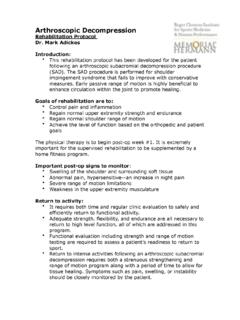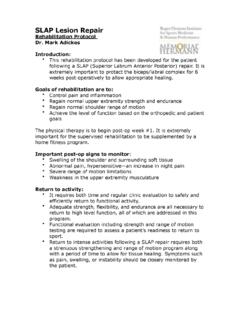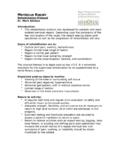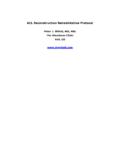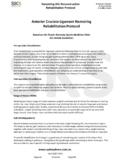Transcription of Pre-op ACL Protocol - Mark Adickes MD | …
1 Pre-op ACL Injury ProtocolDr. Mark AdickesIntroduction: This rehabilitation Protocol is designed for patients with ACL injuries who anticipate returning early to a high level of activity following ligament reconstruction. Goals of rehabilitation are to: Control joint pain, swelling, hemarthrosis Regain normal knee range of motion Regain a normal gait pattern Regain normal lower extremity strength Regain normal proprioception, balance, and coordination The physical therapy is to begin immediately upon injury. It is extremely important for the supervised rehabilitation to be supplemented by a home fitness post-op signs to monitor: Swelling of the knee or surrounding soft tissue Abnormal pain response, hypersensitive Abnormal gait pattern, with or without assistive device Limited range of motion Weakness in the lower extremity musculature Readiness for surgery: Prior to surgery it is crucial for the injured knee to be free of swelling and pain.
2 Full extension must be present. Full flexion is preferred but at least 120 degrees of flexion must be present. A normal gait should be present prior to surgery. Any overlying skin injuries must be Mark AdickesRange of Motion: Passive ROM, No limits Aggressive Patella mobility Ankle pumps Gastroc-soleus stretches Wall slides Heel slides with towelStrength: Quad sets x 10 minutes SLR (flex, abd, add) Multi-hip machine (flex, abd, add) Leg Press (90-20 )-bilateral Mini squats (0-45 ) Multi-angle isometrics (90-60 ) Calf RaisesBalance Training: Weight shifts (side/side, fwd/bkwd) Single leg balance PlyotossWeight Bearing: Wt bearing as tolerated with crutches Crutches until quad control is gained, then discontinuedBicycle: May begin when 110 flex is reachedModalities: E-stim/biofeedback as needed Ice 15-20 minutes with knee at 0 extBrace: Brace should be worn until quad control regained.
3


